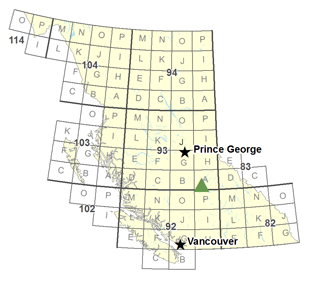Summary
 Late Triassic to Middle Jurassic porphyry deposits in British Columbia are characterized as end members having calc‐alkalic or alkalic affinities (Barr et al., 1976; McMillan et al., 1995; Lang et al., 1995) with both categories, locally occurring as clusters such as at the Highland Valley calc‐alkalic and Mt. Polley alkalic camps. Recent exploration success in the Woodjam camp shows that a cluster of multiple porphyry centres with a narrow age (ca. 197 Ma: MDRU, unpublished) at the margin of the Takomkane batholith have alkalic (e.g., Megabuck), calc‐alkalic (e.g., Southeast Zone), and alkalic to calc‐alkalic characteristics (Deerhorn). Thus, indicating that mineralization in the Deerhorn system seems to have evolved from alkalic to calc‐alkalic host‐rocks and alteration assemblages. Woodjam therefore provides an opportunity to better understand the relationships between alkalic to calkalkalic magmatism and related mineralization, a feature that remains poorly understood.
Late Triassic to Middle Jurassic porphyry deposits in British Columbia are characterized as end members having calc‐alkalic or alkalic affinities (Barr et al., 1976; McMillan et al., 1995; Lang et al., 1995) with both categories, locally occurring as clusters such as at the Highland Valley calc‐alkalic and Mt. Polley alkalic camps. Recent exploration success in the Woodjam camp shows that a cluster of multiple porphyry centres with a narrow age (ca. 197 Ma: MDRU, unpublished) at the margin of the Takomkane batholith have alkalic (e.g., Megabuck), calc‐alkalic (e.g., Southeast Zone), and alkalic to calc‐alkalic characteristics (Deerhorn). Thus, indicating that mineralization in the Deerhorn system seems to have evolved from alkalic to calc‐alkalic host‐rocks and alteration assemblages. Woodjam therefore provides an opportunity to better understand the relationships between alkalic to calkalkalic magmatism and related mineralization, a feature that remains poorly understood. The Woodjam camp provides an excellent locality to develop and increased understanding the significance of these varying geological characteristics. Such knowledge can significantly aid exploration decision making, especially around known porphyry camps, and will provide critical links between these two, apparently end‐member systems. Therefore, this research project is being undertaken in collaboration with Geoscience BC and Gold Fields Canada Exploration, to better characterize the Woodjam porphyry cluster in central British Columbia.
The main objectives of the project are to characterize the host‐rocks and nature of mineralization and alteration at several selected porphyry centers, and to determine their relationships of alkaline and calcalkalic characteristics. These will be integrated with the magmatic evolution in order to establish a model of the evolution of porphyry clusters at Woodjam, and indicate controlling features of alkaline and calc‐alkaline ore types. This will be accomplished through field investigations and various laboratory techniques.